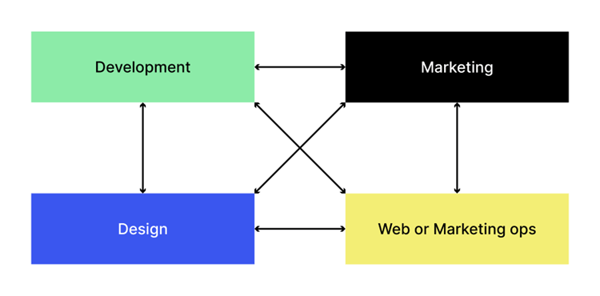Today's customers demand remarkable digital experiences with consistent quality across all touchpoints. Of course, this is easier said than done, especially for enterprises with different brands and a global presence.
So how do you achieve a consistent and unified digital experience across multiple markets? Many enterprises start strong with their digital marketing efforts, but attention often starts to fade as time passes, and they lose control when scaling up.

How brands lose control of digital consistency as they scale up.
At Luxid, we've helped many clients to successfully address these challenges. So, let's look in more detail at the challenges and ways we can deal with these.
1. Inconsistent experiences and distribution problems
Digital experiences are often characterised by fragmentation. Many global enterprises manage a complex network of digital channels, with separate web content management solutions tailored to individual brands or specific countries. Just rolling out a single digital change can be quite challenging with such organisational complexity.
The issues that global enterprises face broadly fall into two areas: technology and content strategies. Technology can hinder efficient deployments. Common problems include regions using different content management systems, misuse of technology, functionality limitations (such as a master copy), and even bugs.
Managing global content is challenging simply because of the sheer quantity of content, locales, or brands that must be handled. And when it comes to distribution, many organisations simply do not have a clear content strategy.
2. Locales going their own way
Locales start doing their own thing because global or central teams are lagging, cannot deliver, or are not paying attention. This can lead to a fragmented technology stack or disconnected brand design/voice. Typically, this problem develops over time, resulting from a lack of clear processes and workflows. It leaves locales frustrated, without opportunities to move forward, and disconnects them - consciously or unconsciously - from the global or central office. Unless these problems are addressed early, they can become challenging to manage.
3. Hidden total cost of ownership
Do you know your company's annual expenditure for its online environments, platforms, and activities? Fragmented web content management solutions usually result in concealed expenses. And we're not just talking about licenses and maintenance.
Content can be produced in multiple places – sometimes outsourced to a local agency - impacting the costs of getting it online. You also have the hidden costs of being held back. With fragmented systems, content, and experiences, you cannot gather data properly on your audience and, therefore, cannot properly deliver personalised experiences.
4. Incorrect team set-ups
Workflows and processes only get you so far. Your team set-up is equally essential. Do you have a dedicated web or marketing ops team? A team that manages, organises, and publishes the new content? Do all the locales, brands, or units in your organisation have the same maturity or budget?
All of these factors can affect the quality of your digital experiences. Even with the right dedicated teams, they can become disconnected from other functions such as design, development, or marketing. This can result in incorrect use of design and technology, leading to operational inefficiencies and ineffective marketing.

How Web/marketing ops can be disconnected from development and design.
Unfortunately, there are no universal solutions to these problems. Each company is unique and has its own set of requirements and approaches. However, we can offer tried and tested concepts to consider when developing a strategy to improve your digital experiences.
1. Get your technology right
Identifying a centralised content management system (CMS) is a great place to start. Consider using a CMS that can cover all your locales, languages, and brands. The ultimate solution here is a Digital Experience Platform (DXP). While you do not have to use all the functionality, DXPs usually allow you to tackle many of the key technology challenges you will face.
Gartner defines a digital experience platform (DXP) as "an integrated set of core technologies that support the composition, management, delivery, and optimisation of contextualised digital experiences." In short, it's a platform where content and analytics come together to create optimal experiences across multiple channels.
Adobe experience manager (AEM) and Coremedia are platforms offering lots of capabilities with excellent track records in a single system. A system like Contentful is not an actual DXP but can play a vital role. Contentful refers to itself as an integral part of a Digital Experience Stack (DXS) and leans into the 'composable architecture' approach, where multiple platforms and systems are connected. This enables organisations to select the best fit and breadth of a system without depending on a single suite.
Centralising your tech stack has many benefits over just having the content in one place. It simplifies and often reduces the total cost of ownership (TCO). Licenses, security, and maintenance also become significantly easier to manage.
2. Roll out the right content strategy
The right technology allows you to master content rollouts on global and central scales. This enables businesses to standardise with the same tone of voice and design across all regions.
Designing your user experience falls into the same category as distributing content via UX components. Centralising the design, control, and user experience guidelines enables businesses to 'white label' and ensure all locales and brands can use it properly, improving TCO, efficiency, and reusability.
However, in the complex landscape of multinational organisations, finding the right balance between global governance and local flexibility is crucial. It means seizing local market opportunities while safeguarding the organisation's brand image. This can be tricky.
While Locales often take pride in their independence, compromises are usually necessary to streamline operations. This can involve relinquishing some autonomy to ensure cohesive functionality across the organisation.
To navigate this intricate balance, appointing a global platform owner is imperative. This individual serves as the orchestrator, ensuring a fair and effective balance between fulfilling local needs and achieving the broader global goals of the organisation. The global platform owner is pivotal in harmonising diverse perspectives and objectives to drive overall success.
3. Creating the right team set-up
Your enterprise might have its technology and governance all in order, but have you considered the operational aspect of getting your content online? Multiple locales, brands, languages, or products with a global audience can scale quickly. This means a dedicated team is necessary to organise and execute the content. Typically, this is the same team ensuring compliance with global governance rules.
This team must be connected or even integrated with the development and design teams to ensure design systems and technology are used as intended and efficiently as possible. This creates a constant feed of improvements between the design systems and technology.

Web/marketing ops team working together with other teams.
Digital experience management requires a thoughtful and unified approach that considers the future. Existing systems and workflows must be carefully redesigned or replaced to achieve this.
This might sound daunting, but you don't have to roll it out everywhere at once. It can start as a scalable and logical design for experience management in one territory or brand, so long as it encompasses multiple variables such as countries, languages, or websites because that's where the complexity lies.
The idea is to test, monitor and improve your systems and workflows, which then can be rolled out to new brands or areas and eventually cover the entire company.
Your customers and internal stakeholders will greatly value engaging, consistent, high-quality experiences. At Luxid, we can help you through the complete journey of maturing to the highest levels of digital experience management. Simply give us a shout if you want to know more.










